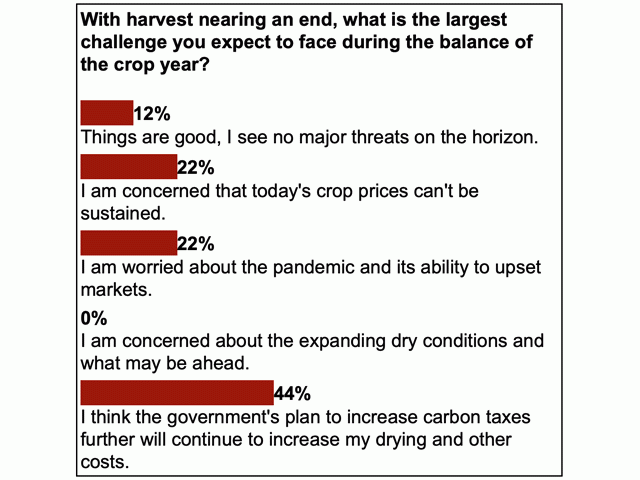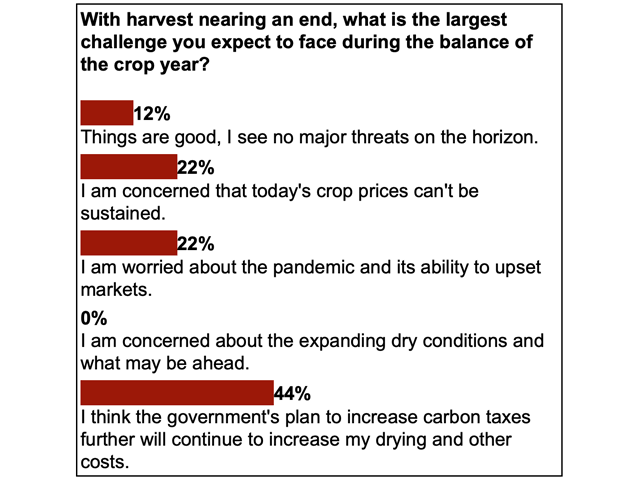Canada Markets
What Readers are telling Us in DTN 360 Polls
DTN's 360 Poll is an unscientific poll that allows readers to share their thoughts on issues within the industry as they arise.
Here is a look at some of the most recent poll findings:
WHICH CROPS HAVE BULLISH POTENTIAL?
When producers were asked which crops have the most bullish potential for 2020-21, the oilseeds gained the most votes in this poll. Of the readers who responded, close to 60% chose either soybeans or canola as having the greatest potential. China's aggressive pace of soybean buying from the U.S. combined with a dry forecast for major South American buyers presents a potential bullish setup for the oilseed markets.
The Nov. 5 session saw January soybeans, February rapeseed and January Malaysian palm oil all reach fresh contract highs. The risk in this market is the potential for an overstated demand forecast for China, with a contract cancellation being the worst-case scenario that could lead to selling pressure. At the same time, the massive net-long position held by noncommercial traders remains a risk and could lead to a sudden change in sentiment and market direction.
Respondents saw a much lower potential for wheat, durum and other crop, while oats, barley and corn received no responses.
P[L1] D[0x0] M[300x250] OOP[F] ADUNIT[] T[]
Statistics Canada opted for a model-based approach to estimate crop production based on July data as the result of constraints due to the COVID-19 pandemic, while this report was followed by the model-based report released just weeks later based on August data. This move could be an exception, but long-term goals include a greater reliance on model-based estimates.
FEELINGS ABOUT PRODUCER SURVEYS
When producers were asked if they are in favour of the current direction that would lessen the reliance on producer surveys, there were responses for all choices shown, showing a wide range of opinion on this matter. The largest response, or 40% of respondents, indicated that they are totally in favor of the current direction although would prefer a quicker release of findings. An additional 10% of respondents are somewhat in favour of this direction.
At the same time, 20% of respondents are against the move, indicating that producer surveys are the best alternative. A further 30% of respondents are either unsure, or don't care.
THOUGHTS ON STATISTICS CANADA PRODUCTION ESTIMATES
On a similar subject, producers were also asked in a recent poll what they thought of the most recent Statistics Canada production estimates based on a model-based approach using August data. While it may be difficult to come to a conclusion based on the responses to this informal poll, 40% of respondents indicated that they think the agency's production estimates are wrong, while a further 20% of respondents indicated that the prairie crop is overstated. Close to two-thirds showed some degree of concern. Another 20% of respondents indicated they viewed the results as accurate, while a similar number indicated they did not follow the report. Statistics Canada is poised to release its final production estimates on Dec. 3, the first production estimates based on producer surveys.
BIGGEST CHALLENGE AHEAD
As seen on the attached chart, when producers were shown a number of potential challenges expected to be faced in 2020-21, there were no responses to the choice of dry conditions, while modest concern was expressed over the pandemic's effects and the notion that current crop prices can't be sustained. An estimated 44% of respondents indicated the government's plan to increase carbon taxes as their largest concern. While the current federal plan has the carbon tax rising by $10/mt each year until $50/mt is hit in 2022, Canada's Parliamentary Budget Office has estimated that higher taxes are needed for Canada to hit its Paris Accord obligations. The office has estimated this tax must increase to $117/mt by 2030, if it is applied across all industries. A potential win by the Democrats in the U.S. could see the governing Liberals with increased confidence to move in this direction.
**
DTN 360 Poll
Given the recent losses experienced in the futures trade of the major grains and oilseeds, do you think we've seen the highs for the crop year? You can weigh in with your thoughts on this poll that is found on the lower-right side of your DTN Canada Home Page. Thanks for your input!
Cliff Jamieson can be reached at cliff.jamieson@dtn.com
Follow him on Twitter @Cliff Jamieson
(c) Copyright 2020 DTN, LLC. All rights reserved.






Comments
To comment, please Log In or Join our Community .